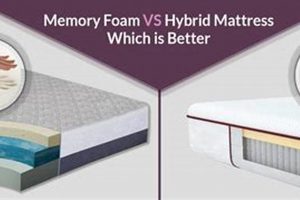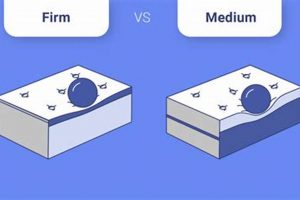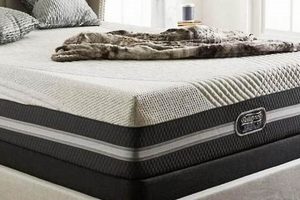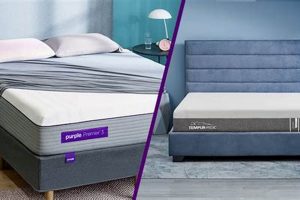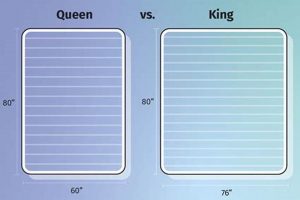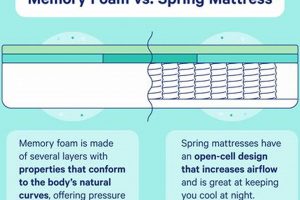The selection of appropriate bedding is crucial for optimal sleep quality and overall well-being. Two prominent categories dominate the contemporary market: those incorporating multiple material types and those constructed primarily from viscoelastic or polyurethane materials. The former often combines the support of innerspring coils with the comfort layers of materials like memory foam or latex. The latter typically relies entirely on different densities of foam to achieve both support and cushioning.
The emergence of multi-material designs represents an evolution in sleep technology, aiming to address the limitations of earlier all-foam models, particularly regarding heat retention and support. Historically, all-foam options gained popularity due to their pressure-relieving qualities and motion isolation, proving particularly beneficial for couples. However, consumers increasingly sought designs offering improved breathability and edge support, leading to the development and refinement of layered construction methods. These layered construction methods strive to balance pressure relief with a more responsive and supportive feel.
This article will delve into the specific characteristics of these two mattress types, providing a detailed comparison of their construction, performance, and suitability for various sleep preferences and needs. Key factors such as support, comfort, temperature regulation, motion isolation, and durability will be examined to assist consumers in making an informed decision.
Considerations for Bedding Selection
The following guidelines are offered to assist individuals in selecting a mattress that aligns with their specific needs and preferences. Careful consideration of these factors can lead to improved sleep quality and long-term satisfaction.
Tip 1: Prioritize Support. Evaluate the level of spinal alignment offered by each mattress type. Multi-material designs often provide enhanced edge support and overall stability compared to all-foam options, which may be crucial for individuals with back pain or those who prefer sleeping near the edge.
Tip 2: Assess Pressure Relief. Determine the degree of cushioning required based on sleeping position and individual sensitivity. All-foam models excel at conforming to the body’s contours, which can alleviate pressure points. Consider the density and type of foam used, as this significantly impacts the level of pressure relief provided.
Tip 3: Evaluate Temperature Regulation. Understand the breathability characteristics of different materials. Models with innerspring coils generally allow for better airflow compared to dense foam constructions. Look for features such as gel-infused foam or breathable covers, which can help regulate temperature and minimize heat retention.
Tip 4: Compare Motion Isolation. If sharing a bed, assess the mattress’s ability to isolate movement. All-foam models are typically superior at preventing motion transfer, minimizing disturbances caused by a partner’s movements. Check product specifications or read reviews to gauge the degree of motion isolation provided.
Tip 5: Investigate Durability. Consider the long-term performance and lifespan of each mattress type. Models with high-quality materials and robust construction tend to be more durable. Research the density of the foam and the gauge of the coils used, as these factors directly impact longevity.
Tip 6: Acknowledge Budget Constraints. Establish a realistic budget before beginning the selection process. Mattresses are available at a wide range of price points, and the optimal choice will depend on balancing desired features with financial considerations. Explore different brands and models to find the best value for the investment.
Careful evaluation of these critical parameterssupport, pressure relief, temperature regulation, motion isolation, durability, and budgetallows for informed and appropriate bedding selection. Thoroughly assess personal requirements against the capabilities of differing designs to promote superior sleep quality and lasting satisfaction. The subsequent sections will elaborate on how these types can accommodate specific needs.
1. Construction Materials
The fundamental distinction between hybrid and foam mattresses lies in their constituent materials. Foam mattresses, at their core, are constructed using varying densities and types of foam, including polyurethane, memory foam, and latex. The configuration of these layers determines the mattress’s overall support, comfort, and pressure-relieving properties. For example, a typical foam mattress might incorporate a high-density polyurethane foam base for support, a memory foam layer for contouring, and a softer comfort layer for immediate cushioning. Conversely, hybrid mattresses integrate a support core of innerspring coils with comfort layers composed of materials such as memory foam, latex, or even gel-infused foam. The coil system provides the primary support structure, while the additional layers offer enhanced comfort and pressure relief. The choice of materials in each layer and their arrangement profoundly influence the performance characteristics of each mattress type.
The selection of construction materials directly impacts several key performance indicators. The type and gauge of the coils in a hybrid mattress, for instance, determine its level of support and responsiveness. Similarly, the density and composition of the foam layers affect the mattress’s ability to conform to the body and alleviate pressure points. For example, high-density memory foam is known for its superior pressure relief but can also trap heat, while latex offers a more responsive and breathable alternative. In all-foam mattresses, the arrangement of different foam layers is crucial for achieving the desired balance of support and comfort. A poorly constructed foam mattress may lack adequate support or suffer from premature sagging, whereas a well-designed one can provide exceptional comfort and pressure relief.
Ultimately, understanding the construction materials used in both hybrid and foam mattresses is critical for making an informed purchasing decision. Consumers should carefully consider the specific properties of each material and how they contribute to the overall performance of the mattress. Factors such as support, comfort, temperature regulation, and durability are all directly influenced by the materials used in construction. A thorough evaluation of these factors, coupled with an understanding of individual sleep preferences and needs, will lead to a more satisfactory and long-lasting sleep experience.
2. Support System
The support system represents a core differentiating factor. In hybrid mattresses, this system typically comprises an innerspring coil unit, often with individually pocketed coils designed to minimize motion transfer and conform to body contours. The gauge and arrangement of these coils directly impact the mattress’s firmness and ability to maintain spinal alignment. Conversely, foam mattresses rely entirely on the density and configuration of foam layers for support. High-density polyurethane foam commonly serves as the base layer, providing foundational support, while other layers, such as memory foam or latex, contribute to pressure relief and contouring. The effectiveness of the support system directly influences sleep quality, impacting spinal health and overall comfort.
The selection of a suitable support system necessitates considering individual sleeping habits and physical requirements. For instance, individuals with back pain may benefit from the enhanced support offered by a hybrid mattress with a robust coil system. The coils provide a more responsive and resilient support structure, preventing excessive sinking and maintaining proper spinal alignment. Alternatively, individuals seeking maximum pressure relief, particularly those with joint pain, may find all-foam mattresses more suitable. The conforming properties of memory foam can distribute weight evenly, reducing stress on pressure points. A practical example lies in the design of mattresses for hospitals, where all-foam designs are frequently used to minimize pressure ulcers in bedridden patients. In either case, the performance of the chosen support system directly dictates the level of comfort and therapeutic benefit experienced.
In summary, the support system is a critical component that distinguishes hybrid and foam mattresses. Hybrid designs leverage innerspring coils to provide resilient support and spinal alignment, while foam designs rely on foam density and layering for contouring and pressure relief. The optimal choice hinges on individual needs and preferences, requiring a careful evaluation of sleeping habits, physical conditions, and desired comfort levels. Recognizing the strengths and weaknesses of each support system is paramount for making an informed decision and maximizing sleep quality.
3. Temperature Regulation
Temperature regulation is a crucial factor in mattress selection, directly influencing sleep comfort. In the context of “hybrid vs foam mattress,” significant differences exist in their ability to dissipate heat. Foam mattresses, particularly those made with memory foam, have a propensity for heat retention. The dense, closed-cell structure of memory foam restricts airflow, trapping body heat and potentially leading to discomfort and night sweats. Conversely, hybrid mattresses, which incorporate innerspring coils, typically offer superior temperature regulation. The open structure of the coil system allows for greater air circulation, facilitating heat dissipation and promoting a cooler sleeping environment. The combination of coils and breathable comfort layers, such as natural latex or gel-infused foam, further enhances temperature regulation in hybrid models.
The design and materials employed in the construction directly impact thermal performance. For instance, a foam mattress with a convoluted or open-cell foam layer can improve airflow compared to a solid block of memory foam. Hybrid mattresses may incorporate breathable fabrics and ventilation channels to augment airflow through the coil system. Real-world examples underscore the importance of temperature regulation. Individuals residing in warmer climates or those prone to night sweats often report greater satisfaction with hybrid mattresses due to their enhanced breathability. Conversely, individuals who prefer a warmer sleeping environment may find the heat-retentive properties of foam mattresses more appealing. The practical significance of this understanding lies in tailoring the mattress selection to individual climate, physiology, and personal preference.
In conclusion, temperature regulation represents a key distinction between hybrid and foam mattresses. While foam mattresses can retain heat due to their dense structure, hybrid mattresses, with their innerspring coil system and breathable materials, generally offer superior airflow and temperature control. This understanding is vital for selecting a mattress that promotes comfortable and restful sleep, particularly for individuals with specific thermal needs or preferences. The challenge lies in balancing temperature regulation with other factors, such as support, comfort, and motion isolation, to achieve an optimal sleep experience.
4. Motion Isolation
Motion isolation, the ability of a mattress to minimize the transfer of movement across its surface, is a crucial consideration for couples or individuals sharing a bed. The effectiveness of motion isolation significantly impacts sleep quality by reducing disturbances caused by a partner’s tossing, turning, or getting in and out of bed. Understanding the differences in motion isolation between hybrid and foam mattresses is essential for informed decision-making.
- Material Composition and Dampening
Foam mattresses, particularly those made with memory foam, inherently possess excellent motion isolation properties due to the material’s viscoelastic nature. Memory foam absorbs and dissipates energy, effectively dampening movement and preventing it from propagating across the mattress surface. In contrast, hybrid mattresses, which incorporate innerspring coils, typically exhibit less effective motion isolation. The interconnected nature of the coils can transmit movement, leading to greater disturbance. However, hybrid designs utilizing individually pocketed coils can mitigate this effect by isolating movement to specific areas of the mattress.
- Coil Design and Configuration
The type and configuration of coils within a hybrid mattress play a significant role in its motion isolation capabilities. Individually pocketed coils, where each coil is encased in fabric, move independently, minimizing the transfer of motion. Mattresses with interconnected coil systems, such as Bonnell coils, tend to exhibit poorer motion isolation as movement in one area affects the entire structure. The gauge and height of the coils also influence motion transfer, with thicker and taller coils generally providing less isolation. The choice of coil system is a critical factor in determining the suitability of a hybrid mattress for couples.
- Layer Construction and Foam Density
The layering and density of foam used in both hybrid and all-foam mattresses affect motion isolation. Thicker and denser layers of memory foam or latex contribute to better motion dampening. Hybrid mattresses often incorporate a thick layer of memory foam above the coil system to enhance motion isolation and provide pressure relief. The density of the foam is also important, as higher-density foams are more effective at absorbing movement. The combination of coil design and foam layer configuration determines the overall motion isolation performance of a hybrid mattress.
- Real-World Performance and User Experience
User experiences consistently reflect the superior motion isolation capabilities of all-foam mattresses compared to traditional innerspring mattresses. Reviews and testing demonstrate that movement is significantly less noticeable on all-foam models. However, advancements in hybrid mattress design, particularly the use of pocketed coils and high-density foam layers, have narrowed the gap. Couples often prioritize motion isolation when selecting a mattress, and the choice between a hybrid and foam mattress depends on individual preferences and the sensitivity of each partner to movement. A trial period or thorough testing can help determine the most suitable option.
In summary, while all-foam mattresses typically excel in motion isolation due to their inherent material properties, hybrid mattresses can achieve acceptable levels of motion isolation through careful design and the incorporation of pocketed coils and high-density foam layers. Understanding the interplay between material composition, coil design, layer construction, and user experience is essential for making an informed decision regarding motion isolation in the context of hybrid and foam mattresses. The optimal choice depends on individual needs and the desire to minimize sleep disturbances caused by partner movement.
5. Durability Expectations
Durability constitutes a primary factor in mattress selection, influencing long-term value and overall satisfaction. The expected lifespan differs significantly between hybrid and foam mattresses due to variations in construction and materials. Evaluating these durability expectations is crucial for making a cost-effective and suitable purchase.
- Coil System Fatigue vs. Foam Degradation
Hybrid mattresses rely on innerspring coil systems for support. Over time, these coils can experience fatigue, leading to sagging and reduced support, particularly at the edges. The gauge and quality of the steel used in the coils directly affect their resistance to fatigue. Foam mattresses, conversely, are susceptible to foam degradation, where the foam loses its density and supportiveness, resulting in impressions and reduced comfort. The density and type of foam employed are critical determinants of its resistance to degradation. A high-density polyurethane foam base, for instance, typically exhibits greater longevity compared to lower-density options.
- Material Quality and Density
The quality and density of materials significantly impact the lifespan of both mattress types. In hybrid models, higher-quality steel in the coils and denser foam layers contribute to increased durability. Similarly, in foam mattresses, higher-density foams resist compression and degradation for a longer period. Lower-quality materials are more prone to breakdown, leading to premature sagging and reduced support. The initial investment in higher-quality materials generally translates to a longer lifespan and improved overall value.
- Construction Techniques and Layer Adhesion
The methods used in constructing each mattress type affect its long-term durability. Hybrid mattresses require secure bonding between the coil system and the foam layers to prevent shifting and separation. Similarly, foam mattresses benefit from proper lamination techniques to ensure the various foam layers remain securely adhered. Poor construction can lead to premature wear and tear, reducing the mattress’s lifespan. Reinforced edges and robust stitching can also enhance durability, particularly in hybrid models.
- Warranty Terms and Conditions
Warranty terms provide an indication of the manufacturer’s confidence in the product’s durability. Longer warranty periods typically reflect higher expectations for longevity. However, it’s crucial to carefully review the terms and conditions of the warranty, as they often exclude certain types of damage or wear and tear. Common exclusions include sagging exceeding a certain depth, stains, and damage resulting from improper use. Understanding the warranty coverage is essential for assessing the overall value and long-term cost of the mattress.
In conclusion, durability expectations vary considerably between hybrid and foam mattresses, influenced by factors such as coil fatigue, foam degradation, material quality, construction techniques, and warranty terms. While hybrid mattresses may offer greater edge support initially, foam mattresses can provide consistent support over time if constructed with high-density materials. Evaluating these factors and considering individual needs and preferences is critical for selecting a mattress that provides lasting comfort and value. The trade-offs between initial cost and long-term durability should be carefully weighed to make an informed purchasing decision.
6. Cost Considerations
Financial outlay is a primary factor influencing consumer choice in the mattress market. The decision between hybrid and foam mattresses often hinges on budgetary constraints and a perceived value proposition, warranting a detailed examination of cost-related aspects.
- Initial Purchase Price
The initial purchase price typically varies significantly between these mattress types. Generally, foam mattresses, particularly those utilizing conventional polyurethane foam, tend to be more economical. This lower cost stems from simpler manufacturing processes and readily available materials. Hybrid mattresses, incorporating coil systems and multiple layers of premium materials like memory foam or latex, often command a higher initial price point. This reflects the increased complexity of construction and the utilization of more expensive components.
- Material Composition and Pricing
Material composition directly influences mattress cost. High-density memory foam, natural latex, and individually pocketed coils contribute to increased pricing in both mattress categories. Hybrid models, by their nature, incorporate a wider range of materials, potentially elevating their overall cost. The gauge of the coils, the density of the foam layers, and the type of cover fabric all affect the final price. Examining the specifications of each component provides insight into the pricing strategy and the expected performance characteristics.
- Long-Term Value and Durability
While initial cost is a significant consideration, long-term value and durability play a crucial role in assessing the overall cost-effectiveness. A less expensive mattress with a shorter lifespan may ultimately prove more costly than a higher-priced model that offers superior durability and sustained comfort. Evaluating warranty terms, material quality, and expected lifespan is essential for determining the true cost of ownership. Hybrid mattresses, with their robust coil systems, may offer greater longevity, while high-density foam mattresses can also provide extended durability if properly maintained.
- Special Features and Brand Premiums
Special features, such as cooling technologies, zoned support systems, and organic certifications, often contribute to increased mattress prices. Furthermore, established brands may command a premium due to perceived quality, reputation, and customer service. Evaluating the value of these features and brand affiliations requires careful consideration of individual needs and preferences. A basic, no-frills mattress may suffice for some individuals, while others may be willing to pay extra for enhanced comfort and specialized features.
Ultimately, selecting between hybrid and foam mattresses requires balancing budgetary constraints with performance expectations and long-term value considerations. Assessing initial purchase price, material composition, durability, and brand premiums provides a comprehensive understanding of the cost implications associated with each mattress type, enabling consumers to make an informed decision that aligns with their specific needs and financial capabilities.
Frequently Asked Questions
This section addresses common inquiries concerning the selection between hybrid and foam mattresses. These questions aim to provide clarity on key performance characteristics and suitability factors.
Question 1: How does the support structure differ between hybrid and foam mattresses?
Hybrid mattresses employ innerspring coil systems to provide foundational support, often incorporating individually pocketed coils to minimize motion transfer. Foam mattresses rely entirely on varying densities of foam, such as high-density polyurethane, to achieve support. The coil system in hybrids typically offers a more responsive and resilient support structure, while foam options contour to the body for pressure relief.
Question 2: Which mattress type excels in temperature regulation?
Hybrid mattresses generally provide better temperature regulation due to the open structure of the coil system, which facilitates airflow. Foam mattresses, particularly those made with memory foam, tend to retain heat due to their dense, closed-cell structure. However, certain foam mattresses incorporate features like gel infusions or open-cell foam to improve breathability.
Question 3: How does motion isolation compare between hybrid and foam mattresses?
Foam mattresses, especially those with memory foam, typically offer superior motion isolation. The viscoelastic properties of foam absorb and dampen movement, minimizing disturbances caused by a partner’s movements. Hybrid mattresses can achieve acceptable levels of motion isolation through the use of individually pocketed coils, but generally do not perform as well as all-foam models.
Question 4: What are the typical durability expectations for each mattress type?
Durability expectations vary based on material quality and construction. Hybrid mattresses are subject to coil fatigue over time, potentially leading to sagging. Foam mattresses are susceptible to foam degradation, resulting in body impressions. Higher-density foams and robust coil systems contribute to increased longevity in both types.
Question 5: Which mattress type is generally more cost-effective?
Foam mattresses, particularly those constructed with conventional polyurethane foam, are often more economical due to simpler manufacturing processes. Hybrid mattresses, incorporating coil systems and multiple layers of premium materials, typically command a higher initial price. However, long-term value and durability should be considered when assessing cost-effectiveness.
Question 6: Which type of sleeper benefits most from a hybrid mattress, and who benefits from a foam mattress?
Hybrid mattresses tend to suit individuals who prefer a responsive and supportive feel, particularly those who sleep on their back or stomach. Foam mattresses often benefit side sleepers seeking pressure relief and contouring. Individuals with back pain may prefer the enhanced support of a hybrid, while those sensitive to motion transfer may find foam more suitable. Ultimately, the optimal choice depends on individual sleep preferences and needs.
In summary, the selection between hybrid and foam mattresses necessitates careful consideration of support, temperature regulation, motion isolation, durability, and cost factors. Evaluating individual sleep preferences and physical requirements is crucial for making an informed decision.
The subsequent section will provide practical guidance on selecting the appropriate mattress based on specific sleep requirements and lifestyle considerations.
Conclusion
The preceding analysis clarifies the salient distinctions between hybrid and foam mattress designs. The assessment encompasses support mechanisms, thermal properties, motion isolation capabilities, durability expectations, and cost implications. Through a detailed examination of these parameters, consumers can better understand the trade-offs associated with each type and their suitability for varying needs and preferences. Consideration of these factors promotes well-informed purchasing choices.
The selection of sleep surfaces warrants careful deliberation, recognizing the potential impact on long-term health and well-being. Future advancements in materials science and manufacturing techniques may further refine the performance characteristics of both hybrid and foam mattress designs. The onus rests on consumers to remain informed and critically evaluate their individual requirements to optimize sleep quality through appropriate bedding selection.


